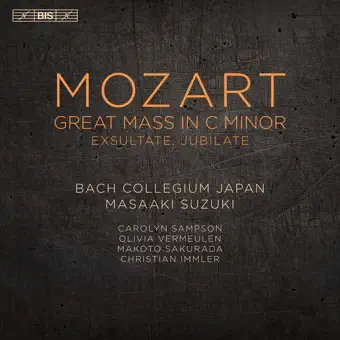december 2016
Mozart: Great Mass in C Minor & Exsultate, Jubilate
Bach Collegium Japan o.l.v. Masaaki Suzuki
Masaaki Suzuki levert een prachtig gespeelde, krachtig getimede en prachtig gezongen Mis in c-klein, waarin de gebedskracht, passie en vreugde voelbaar zijn.
‘Als pakket is de schijf als geheel zeker een winnaar; de Mis scoort gemakkelijk naast de benchmarks voor historische instrumenten.’ Gramophone 2017 Choral Award

C mineurmissen met instrumenten uit die tijd worden steeds beter. De lat werd halverwege de jaren 80 gelegd door Gardiner en Hogwood, en in het nieuwe millennium verhoogd door mensen als McCreesh, Krivine en Langrée. Deze nieuwe opname uit Japan, die zich aansluit bij Suzuki's wetenschappelijke en verrassende Requiem, is het helemaal waard om zich bij hen te voegen. Toen ik het Requiem (1/15) recenseerde, was ik teleurgesteld dat de akoestiek en de techniek de innerlijke stemmen vervaagden, waardoor het contrapunt van Mozart (of Süssmayr, Eybler of Suzuki Jnr) werd uitgewist. Hier wordt dat probleem grotendeels vermeden in een vergelijkbaar grootse akoestiek: dat, en het feit dat de C mineurmis een veel meer vocaal georiënteerd stuk is dan het Requiem.
Het koor is goed gedrild en de twee vrouwelijke solisten zijn net zo goed op elkaar afgestemd als op de cd (zie mijn verzameling over het werk, 6/13). Carolyn Sampson neemt het grootste deel van de sopraansolo's voor zijn rekening (de 'Laudamus' wordt gespeeld door de tweede sopraan, Olivia Vermeulen, zoals gebruikelijk) en doet dat met de lenige coloratuur, rijke, zijdezachte toon en aangeboren identificatie met deze muziek die bekend is van haar heilige Mozart-collectie met The King's Consort (Hyperion, 5/06), en verweeft zich op memorabele wijze met Olivia Vermeulen in het duet en trio van de Gloria. Suzuki is geen snelheidsduivel (een hele minuut langzamer dan Langrée in het Kyrie, bijvoorbeeld), en behoudt de doorgaande lijn in meer inspannende bewegingen zoals de 'Qui tollis' en de 'Cum Sancto Spiritu'-fuga die de Gloria afsluit. Hij neemt zijn tijd, vooral in de 'Et incarnatus est', de prachtige pastorale scène die betoverend door Sampson wordt uitgesponnen.
De editie die van dit verleidelijk onvoltooide werk is gebruikt, is die van Franz Beyer, gepubliceerd in 1989. Er is hier niets dat de algemene luisteraar in verwarring brengt; degenen voor wie dergelijke zaken belangrijk zijn, zullen echter willen weten dat er geen (redactionele) trompetten in de 'Credo' of hoorns in de 'Incarnatus' zijn, waarvan de nieuwe strijkerspartijen misschien actiever zijn dan die in de meer gebruikelijke HC Robbins Landon-voltooiing. (Beyer bedacht ook een Agnus Dei uit de muziek van het Kyrie, maar die is hier niet opgenomen.) Aangezien de enige andere opname van deze editie die van Harnoncourt is, waarvan de eigenaardige balans tussen stemmen en instrumenten een heikel punt is, is het de moeite waard om Beyer's werk op deze cd te horen.
Sampson is opnieuw de solist in het populaire Exsultate, jubilate, met als traktatie een parallelle opname van de openingsaria in de ‘Salzburg’-versie, die een andere tekst en fluiten in plaats van hobo’s heeft. Als geheel is de cd zeker een winnaar; de mis kan gemakkelijk worden gerangschikt naast de benchmarks voor periode-instrumenten. [Deze recensie is bijgewerkt met een correctie over de zangers in de ‘Laudamus te’ – Ed

Period-instrument C minor Masses get better and better. The bar was set in the mid 1980s by Gardiner and Hogwood, then raised in the new millennium by the likes of McCreesh, Krivine and Langrée. This new recording from Japan, which joins Suzuki’s scholarly and startling Requiem, is fully worthy to join them. Reviewing the Requiem (1/15), I was disappointed that the acoustic and engineering blurred the inner voices, obliterating Mozart’s (or Süssmayr’s, Eybler’s or Suzuki Jnr’s) counterpoint. Here that problem is largely avoided in a similarly grand acoustic: that, and the fact that the C minor Mass is a far more vocally orientated piece than the Requiem.
The choir are well drilled and the two female soloists are matched as well as any on disc (see my Collection on the work, 6/13). Carolyn Sampson takes the bulk of the soprano solos (the ‘Laudamus’ is taken by the second soprano, Olivia Vermeulen, as is traditional) and does so with the lithe coloratura, rich, silky tone and innate identification with this music familiar from her sacred Mozart collection with The King’s Consort (Hyperion, 5/06), and intertwines memorably with Olivia Vermeulen in the duet and trio of the Gloria. Suzuki is no speed merchant (a full minute slower than Langrée in the Kyrie, for example), and maintains the through line in more strenuous movements such as the ‘Qui tollis’ and the ‘Cum Sancto Spiritu’ fugue that closes the Gloria. He takes his time especially in the ‘Et incarnatus est’, its beautiful pastoral scene spun out mesmerisingly by Sampson.
The edition used of this tantalisingly incomplete work is that by Franz Beyer, published in 1989. There is nothing here to discombobulate the general listener; however, those for whom such matters are important will wish to know that there are no (editorial) trumpets in the ‘Credo’ or horns in the ‘Incarnatus’, whose new string parts are perhaps more active than those in the more usual HC Robbins Landon completion. (Beyer also contrived an Agnus Dei from the music of the Kyrie but that is not recorded here.) As the only other recording of this edition is Harnoncourt’s, whose peculiar balance between voices and instruments is a sticking point, it is worthwhile to hear Beyer’s work on this disc.
Sampson is once again the soloist in the popular Exsultate, jubilate, the treat here being a parallel recording of the opening aria in the ‘Salzburg’ version, which boasts a different text and flutes instead of oboes. As a package, the disc as a whole is certainly a winner; the Mass easily ranks alongside the period-instrument benchmarks. [This review has been updated to take in a correction about the singers in the ‘Laudamus te’ – Ed
